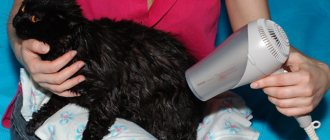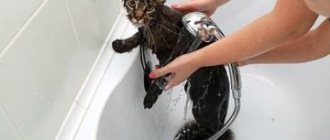Often doubts creep into the minds of cat breeders that cannot find a rational explanation: why cats are afraid of water. Are they really afraid of her? After all, when a cat reacts to splashes, its pupils do not dilate, it does not try to attack or hide in a corner - it simply closes its eyes and tries to run away.
If you try to wash your pet in the shower or pour water on it, the reaction of fear is obvious:
- the pupils will dilate;
- the pulse will increase;
- attempts are made to escape into a dark corner.
When should you wash your cat?
Cats themselves are clean animals, but despite this, experts recommend washing them in the following cases:
- heavy pollution, for example, after walking outside;
- formation of tangles;
- dullness and loss of shine of wool;
- treatment for various parasitic and infectious diseases, as well as allergic reactions using specialized means;
- participation in the exhibition - the animal is bathed using professional cosmetics to make the coat shiny and thick;
- scheduled haircut at the groomer;
- if for some reason the animal is forced to go to the toilet in diapers, you should approach the procedure carefully, since bathing can lead to a worsening of the current disease, so you should consult a veterinarian before carrying out the procedure.
It is worth keeping in mind that many cats are afraid of water. And this is quite natural. Apart from the fact that a wet cat is cold, in this form it is completely helpless, its smell is distinct, and therefore enemies can attack, because the cat is a real predator. We recommend reading the article why cats are afraid of water and what to do about it. To accustom an animal to bathing, experts recommend doing the first one at an early age. It is more difficult to accustom an adult pet to water. In addition, it is important to create comfortable conditions: exclude loud sounds, do everything gradually. Afterwards, for persistence, you should offer the cat a treat or a toy.
Cat bathing procedure
Place a container of water at hand level, for example, in a sink. Hold the cat so that it cannot move its paws. Talk kindly to your pet and do everything carefully, without causing pain or discomfort to the animal:
- Gradually lower the cat into the basin. Wet the fur by scooping water into your palm and pouring it over your pet, stroking it as you do so. Never pour water on your head to prevent water from getting into your ears, eyes and nose;
- Lather the animal with shampoo according to the instructions. If you use an emulsion to eradicate parasites, you will need to leave the product on for 5-15 minutes;
- Rinse the animal several times until the water in the basin is clean, also avoiding getting it on the head.
- Carefully remove the animal and wrap it in a towel. Do not squeeze the fur so as not to hurt your pet;
- Leave the cat in a warm room until completely dry;
- Brush your cat when dry.
You can let your pet outside no earlier than 12 hours after bathing.
If you repeat this procedure regularly and carefully, your pet will get used to it and bathing will be a pleasure for him. Get your kitten accustomed to bathing from childhood to avoid problems in the future. Did you like the article? Share with your friends!
How often can you wash a kitten and cat?
Kittens under one year old should not be washed frequently, no more than once a month. If your baby has a bad day and gets dirty, wash only the dirty area, be it paws, butt, etc. If necessary, simply wipe the rest of the wool with a damp sponge.
An adult cat should not be washed unnecessarily more than once every three months during the cold season (i.e., once each in autumn and winter, maximum); in spring and summer, you can wash it a total of four times. However, it should be taken into account that the number of water procedures depends, among other things, on the breed of the animal (length of fur), conditions of detention, and habitat. Thus, cats that do not have hair are bathed much more often than long- or short-haired cats, namely once every two weeks in the summer, and once a month in the winter. Pets are washed more often if they live in large cities, near a highway, or in an environmentally unfavorable area.
Angora cat
8 eternal kittens: the smallest cat breeds
The cat was brought to Europe from Byzantium from the city of Angora, so the name of the breed is consonant with the city where it came from. Angora was so loved by the inhabitants of Europe and Russia that Angora cats began to be called all representatives of cats with white long or semi-long fur.
The remarkable thing about the Turkish Angora breed is its multi-colored eyes. One eye is yellow, the other is blue. The Angora is very attached to its owner and loves to crawl under streams of water when the owner takes a shower. She just loves water. And it wouldn’t hurt to remind the owner of your existence once again.
When to bathe a kitten for the first time
If you bought a kitten, you don’t need to immediately run to bathe it. Moving to a new house is already stressful for a baby, but here you are with your own shower and shampoos. It's better not to touch it for several months. But if a kitten is found on the street, then it needs to not only be washed, but also treated for external parasites, worms, and taken to a veterinarian.
If the baby is less than three months old, it only needs to be combed, you can wipe it with a wet sponge. If the kitten is purebred and you plan to participate in exhibitions, then bathing can begin at 3-4 months. In this case, it is important to start early, since show-class animals must be accustomed to all kinds of procedures and need to live with them.
Can all cats swim?
Despite the fact that cats prefer not to get involved with the water element, they are excellent swimmers from birth. Absolutely all representatives of the cat family can cover a considerable distance by water. Of course, this does not apply to newborn kittens, who do not have enough control over their bodies to be able to escape if they fall into the water. But already one month old kittens, if lowered to a sufficient depth, will work with their paws, scooping up water.
The ability to swim is an innate instinct of cats
All cats need swimming skills, as do any animals that go hunting. In case the mustachioed animal finds itself in a flood zone, drives its prey to a reservoir, or, on the contrary, the pursuing hunter drives it to the water, the animal is always ready to swim to save its life.
What you need to know when bathing a kitten for the first time
So, the rules for the first bath:
- The kitten should be cheerful and cheerful.
- Not hungry, but not just eaten.
- The room should be warm.
In what cases should you avoid swimming:
- Less than two weeks have passed since vaccinations or treatment against external parasites.
- Having recently been spayed or neutered, it is better not to bathe the cat for at least two more months.
- With a large amount of discharge from the ears or eyes.
Don't wake up your baby and immediately put him in the bath. First, play with him, he should be cheerful.
Bengal cat
Show class cat breed. Very active, playful, constantly purring. They do not show aggression, play actively with children, and treat guests with caution. A highly developed intelligence obliges owners to constantly purchase new puzzle toys for their pets. Bengals are large in size, resemble wild cats in appearance, are graceful, flexible, have a spotted color, and short silky hair.
They simply adore water with a real passion; they love to splash in the water and play with toys in it. Frequent bathing is not recommended, but at exhibitions it is mandatory to use shampoos and conditioners to keep the coat beautiful. Cats love to bathe with their owners, but you should not overdo this activity so as not to wash off the protective layer from the skin and fur.
How to prepare a cat for a bath
Before carrying out the procedure, it is necessary to prepare the work space: place shampoo and a large terry towel within easy reach. You should also set a comfortable water temperature - about 39 degrees. Under no circumstances should you wash your pet in cold or hot water.
To reduce the noise produced by water, you should first fill the bath with a small amount of water and also reduce the shower pressure, in which case the cat will experience less stress and will tolerate bathing better. The ideal option is to stop using the shower. To do this, you need to prepare a sufficient amount of warm water and a ladle or small saucepan with which you can water your pet.
About one day before the planned bathing, it is recommended to comb your pet thoroughly so that if water gets in, lumps and tangled strands do not form.
If the cat is about to have its first bath, it is necessary to calm it down and avoid loud noises and screams that could frighten it. It is also recommended to carry out the procedure together - one person holds it, the other washes it.
It is recommended to place a rubber mat or terry towel at the bottom of the bath to prevent the cat from slipping on it.
Before placing the cat in the bathroom, shampoo is poured into a specially designated container and diluted in water to form abundant foam.
Preparation
The procedure must be carried out in such a way as not to harm the animal’s mental state or frighten it. Otherwise, the cat will associate bathing with negative emotions, and subsequent implementations of this event will end in the animal’s hysterics. Before you start swimming:
- Fill a couple of basins with water. During the washing process, it is advisable not to use a shower or tap, as the noise of the water can frighten the animal. It is also better to collect water in the container without a pet;
- Place a rubber mat on the bottom of the basin: this way the cat can grab hold of its claws and not slip. The pet will feel more confident;
- The amount of water you need to fill is approximately the size of the animal’s belly. The temperature should be 35-37 degrees Celsius, in the room no colder than 15 degrees;
- Prepare several towels in advance and place them within reach;
- Prepare a special shampoo. You cannot wash your cat with human products: this causes the skin to dry out and provoke the occurrence of skin diseases.
If the cat has long hair, then brush it before bathing to prevent the hair from matting.
Mr. Cat recommends: what products to use to bathe a cat
In order not to harm the condition of your pet’s fur and skin, you need to choose the right shampoo.
- Shampoo is available for oily and dry skin. In the latter case, they reduce the formation of static, add shine, and nourish. Some products contain sebum, that is, a fat-like substance that is secreted by the sebaceous glands, as a result of which the coat is covered with a protective layer. If your pet has oily skin, shampoo helps remove excess oil.
- If your pet has unkempt fur, you should choose a shampoo to remove tangles. The mechanism of action is that positively charged components come into contact with negatively charged hairs, causing the clumps to unravel. The product also gives a healthy shine and elasticity to the coat.
- Tinting shampoo is usually used in preparation for an exhibition to give the coat a pronounced shine and deepen the color. Such products contain coloring pigments that interact unstable with the hair, due to which they are gradually washed off from the pet’s fur. The use of such shampoos for bathing spotted cats is not recommended, as the white areas of the coat may lose their color.
- Lightening agent is used to whiten stains. Most often used before an exhibition.
- A special shampoo for breeds without hair, designed for high-quality skin care. Such products are presented in small quantities on the domestic market, and are also high in cost, so they can be replaced with children's hypoallergenic shampoo.
- Specialized medicinal shampoos are prescribed by a veterinarian to treat skin infections, treat fleas and lice.
For cats that really don’t like to wash themselves, spray or dry shampoos have been created. It is enough to spray them on the wool, and after a few minutes comb it.
Cat bath products are used according to the instructions; if side effects occur or if the contents get into the eyes, ears or nose, you should contact a veterinarian.
Abyssinian cat
Abyssinian cat Photo: Depositphotos
Representatives of this breed have wild colors and a long history. Ethiopia is considered the birthplace of the animal.
Each Abyssinian representative has his own individual character. Abyssinians are very playful. They can reproduce a huge number of different sounds. The animal loves human communication, but does not like hands.
Abyssinians also have an individual attitude towards the water element. Not all representatives of the breed are happy to “take a bath.” However, games with a stream of water are liked by the vast majority.
Features of washing different breeds
Sphynx cats do not have hair, as a result of which their skin is prone to excessive oil production, so it is recommended to bathe cats of this breed more often than others - from 7-9 times a year to once every 2-6 weeks. Between baths, you can wipe your skin with damp hypoallergenic wipes.
You can understand whether a hairless cat needs to be washed by the following signs:
- unpleasant odor;
- fatty deposits on the skin, stickiness;
- dirt in the folds.
Long-haired and semi-long-haired breeds require less frequent bathing. So, Persians and Sibiryaks are bathed once every 1.5-2 months, or even less often. It is recommended to use a shampoo depending on your skin type, as well as a conditioner that prevents the formation of tangles.
Short-haired cats, such as Britons, Scots, Bengals, etc., do not need to be bathed at all, but in general it is better to do this unless absolutely necessary, no more than once every 4-6 months.
Norwegian Forest Cat
nextranks.com
One of the oldest breeds in Northern Europe, it is sometimes confused with the Persian, Turkish Van and Maine Coon. Well, no, this is a completely different cat!
Like a real little Viking, she has well-developed hunting instincts, swims well, climbs trees and is distinguished by rare endurance. At the same time, her character is “Nordic”: calm, balanced, unhurried. This is an excellent option for a family living in a private house, where the Norwegian can play enough and show his hunting nature.
How can you bathe a cat if there is no shampoo?
A large list of cosmetics for the care of cats and kittens of different breeds has been developed. Shampoos are liquid and dry, with different functional characteristics. In a pet store, it’s easy to choose a product suitable for a particular pet for regular use. However, sometimes it is not possible to purchase and use special brands. In this case, information on how to wash a cat if there is no special shampoo is very relevant.
Bathing with substances containing surfactants is carried out in the case of persistent or toxic contaminants for the animal to lick, the appearance of parasites, or problems with the fur due to dirt. Several means of washing a cat without special shampoo can be found in most apartments or bought in a regular store. You need to choose formulations without fragrances, preservatives, and with delicate surfactants (no sulfates). The following types are suitable:
- baby liquid soap. It is usually fragrance-free and contains low-irritant surfactants or natural extracts;
- baby shampoo up to 3 years, preferably with a resolution of 0 months;
- adult shampoo “for damaged hair”;
- shampoos with o.
The above cosmetics contain mild cleansing ingredients for delicate skin, a low percentage of fragrances and allergenic substances. Often they do not foam very well, but they add components that relieve irritation and soothe the skin (panthenol, vitamin E, oils and extracts of medicinal plants).
Products with a neutral pH are preferred. Before use, it is advisable to dilute shampoo for adults with o in the proportion of 1 tablespoon per liter volume of water, and apply this solution to the most contaminated areas. After cleansing, the wool is rinsed well with water to remove any remnants of used products. If you have all of the above in your house, it is better to stop at baby liquid soap.
Ways to bathe a cat or wash it if there is no animal shampoo are easy to find if you have knowledge in this matter. Washing with products intended for humans should only be a one-time or infrequent procedure for a pet, carried out in an emergency.
What you need and what you don’t need to do while bathing
Before the procedure, veterinarians recommend thoroughly combing the cat and removing tangles. Then insert cotton balls into your pet's ears or put a special cap on his head. After this, the massage mitten is moistened in water, and a detergent is applied to its surface. After foaming, the shampoo is gently rubbed into the animal’s fur with massage movements. There is no need to press hard, otherwise it will scare the animal even more, and then it will be much more difficult to restrain it.
Bathing a cat in a basin
If you are planning to bathe your cat in a basin, then place it in the bathtub. It is better to line the bottom of the basin with a terry towel or rug so that the cat does not slip. The room in which bathing takes place must be cleared of foreign objects, otherwise they risk ending up in the bathtub (basin) or, worse, on the cat’s head.
Water is also important when bathing an animal. Its temperature should not exceed 40°C and be at least 36°C. Veterinarians pay attention to the proper water level. It should not be higher than the level of the pet's stomach. Therefore, there is no need to fill the bathtub (basin) to the top. If the cat does not feel the bottom under his paws, this can greatly frighten him.
Thermometer for measuring water temperature (without mercury)
Be sure to trim the animal’s claws before the procedure. It is very important. This way you will protect yourself from possible scratches and damage.
Attention! The cat is afraid not so much of the water itself, but of its noise. Therefore, it is better not to turn on the water in front of your pet, but to fill the bath in advance. The shampoo should be washed off under a thin stream of shower or by hand.
There should be no loud sounds, screams, or pressure. Try to be calm and affectionate.
It is more convenient to bathe a cat together. Immediately assign roles - who will hold the animal and who will bathe it. It is better to entrust the bathing process to the person the cat loves most.
Important! Purrs should not wash their noses and ears. This can lead to inflammatory reactions and infection. If a lot of sulfur has accumulated in the hearing organs, and cloudy liquid flows out of the eyes, it is better to use special preparations. We have already written about how to wash a kitten’s eyes. Saline solution is suitable for the same purposes.










